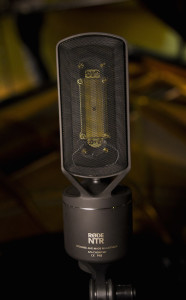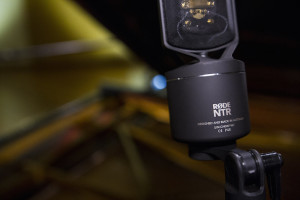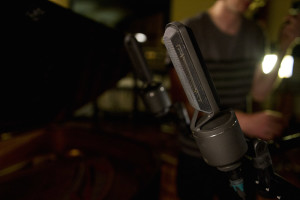Rode NTR Active Ribbon Microphone Review
At one of my earliest recording sessions, I tried to describe a sound I was going for: ”Dark, but not muddy; mid-heavy but not crowded, and with enough high end to peak out, but not so much so that it sounds super modern.”
My engineer at the time, SonicScoop’s own Justin Colletti replied, “Oh, what you want is a ribbon microphone.”
I remember how he proceeded to tell me about these mystical microphones—arcane, often expensive, and so sensitive that if you breathe on them wrong the whole thing would break.
After that discussion, I was almost too scared to even handle ribbon microphones. But I became enamored with them as well. Despite my initial anxiety about these somewhat delicate devices, I have now recorded with a number of ribbon mics over the years and I am amazed how well they perform on some instruments.
My process when working with a ribbon mic is still a bit neurotic, and often includes checking my signal chain about 5 times before making sure the 48v I am about to supply to a condenser is most definitely not going to the ribbon. (There is the potential to damage some vintage ribbon microphones this way if you’re unlucky enough to have a mis-wired cable or jack somewhere in the chain.)
Fretting like this can be exhausting, and I’ve certainly wished more than once that there was an easier way to work with ribbons.
Enter the Røde NTR microphone: An active ribbon built by a company known for delivering quality microphones on a very kind budget. Here is a ribbon mic updated for the modern era. It’s billed as rugged and durable, yet still sensitive in the way this type of microphone should be.
The Black Monolith Appears
When I first received the Røde NTR active ribbon mic in the mail, I was immediately struck by the packaging.
After getting beyond the cardboard sleeve I found myself face to face with a somewhat monolithic black box, accented by a ribbon (zing!) which opened to reveal the mighty microphone itself.
The NTR came encased in snug foam and is smaller than the pictures may have you imagine. Immediately, I noticed how sturdy and well this was built—probably one of the strong suits of this microphone.
The Build: Foolproof and Incapable of Error
Røde has included some very cool additions and considerations to this mic that make an over-cautious person like me feel secure.
First, there is a silver button (called a “travel screw”) on the top that protects the internal ribbon during transport and when not in use. The grill itself is made of a rigid material, but allows a view of the internal ribbon, supposedly giving more transparency to the sound of the microphone. The ribbon is mounted separately from the lower portion of the body, reducing resonance and giving it separation from the base of the mic. And the ribbon itself is ultra thin, making it very sensitive to anything you throw at it.
The bottom of the casing is truly built like a beast and feels as if it is designed to protect a most important treasure from being stolen. It gives the sense that in designing the NTR, Røde really took an extra step to make sure that this thing would be as fool-proof and well-protected as possible.
One of my favorite designs on the mic however is the clip, which hooks in to the bottom and allows the mic to be angled both sideways and up and down without having to move the mic stand itself.
Inside the Studio
During my time with the NTR, I tried it out on about everything I could: FOK drum mic, percussion, vocals, horn, piano, banjo, musical saw and guitar.
As expected, it performed very nicely on the instruments usually associated with ribbons. It gave a hand-held shaker a very nice body and presence. And the NTR placed a flugelhorn part á la Burt Bacharach right in the smooth 1970s land it needed to live in.
I used it in conjunction with an AT4050 on vocals, and the combination of the two provided an excellent blend between thick mids and airy highs (NTR straight on, 4050 above).
On piano and guitar it took a little more massaging and placement to get the sound right, but once I got through that, the sound it provided was round and dark for both instruments.
FOK position on a drum kit was a really nice placement for it, and gave a great and interesting dimension to my fairly standard drum mic’ing.
On musical saw and banjo (maybe not the most common instruments) the NTR allayed some of the harshness of those instruments, and gave both of them a much smoother sound and better placement in the mix.
But how does it compare?
So the question of course is: can I buy this is lieu of a Coles 4038? Will this Røde give me that classic RCA sound? How much should I expect from this mic compared to others?
The good news is that compared to other newer, budget ribbons (Cascade, Avantone) it performs much better for my tastes, and gives a much more balanced sound. I’ve always found that a lot of budget ribbon mics are lacking in head basket design, which contributes to a sound I would describe as “hulking,” something of an unpleasant build up in the lower-mids. The Rode outperforms all these and has a sturdy design that puts it into a superior class.
Compared to other, top-of-the-line ribbon mics however (and to some of the classic mid-priced contenders), it falls a little short. Røde seems to have gone a long way to capture the essence of a ribbon microphone, but like with so much in modern audio, some of the results are a bit hyped. For example, even though the mic is well-balanced, the lower-mids still come forward in a way that seems a little unnatural to my ear.
The microphone has also been criticized by some as being too bright, though I don’t agree with this assessment. I think it would be more accurate to say that the highs are perhaps “glossed over” in a way that doesn’t capture much subtlety in that range. I find that some of the more widely name-checked ribbon mic classics give a bit more high frequency information, but the difference is that their high-end has a more pleasing and gradual roll-off, whereas on the Røde the high-end seems to be more uniform all the way up, though a touch less responsive overall.
There is also a slight bit of a low-mid bump in the Røde that comes forward in a way that asserts “Hello! I am definitely a ribbon microphone!” Again, it’s just a tad more pronounced and hyped-up than your more well-known expensive ribbon brands, but just enough so that I had to listen for this effect and make moves to manage it..
To Buy or Not to Buy?
Røde finds itself in an interesting niche with this mic. Financially, it sits right between the budget ribbons and the pricey ribbons. I would add that the same goes for its sonics.
It has some great features going for it, like the fact that it’s incredibly rugged for such a sensitive ribbon, and also that its mic clip is very durable and allows for great flexibility in placement. Because of this, I feel it has a place in the mic locker of both the home recordist and the professional engineer.
The question for you, as a buyer however, should really be ‘what do I want out of a ribbon mic?’ The NTR, while an excellent option, may not be the perfect ribbon for everyone. If you’re looking for the mythical “one”: A ribbon that will give you vibe and subtlety for days, the NTR can only go so far in that direction. However, if you’re looking for a very dependable, good-sounding and ribbon on a smaller budget, then this might very well be the right choice for you.
Rich Bennett is an engineer, producer, composer, and guitarist who grew up in New York City. He is the owner of Acme Hall Studios, a recording studio and music education space in Park Slope, Brooklyn.
Please note: When you buy products through links on this page, we may earn an affiliate commission.









